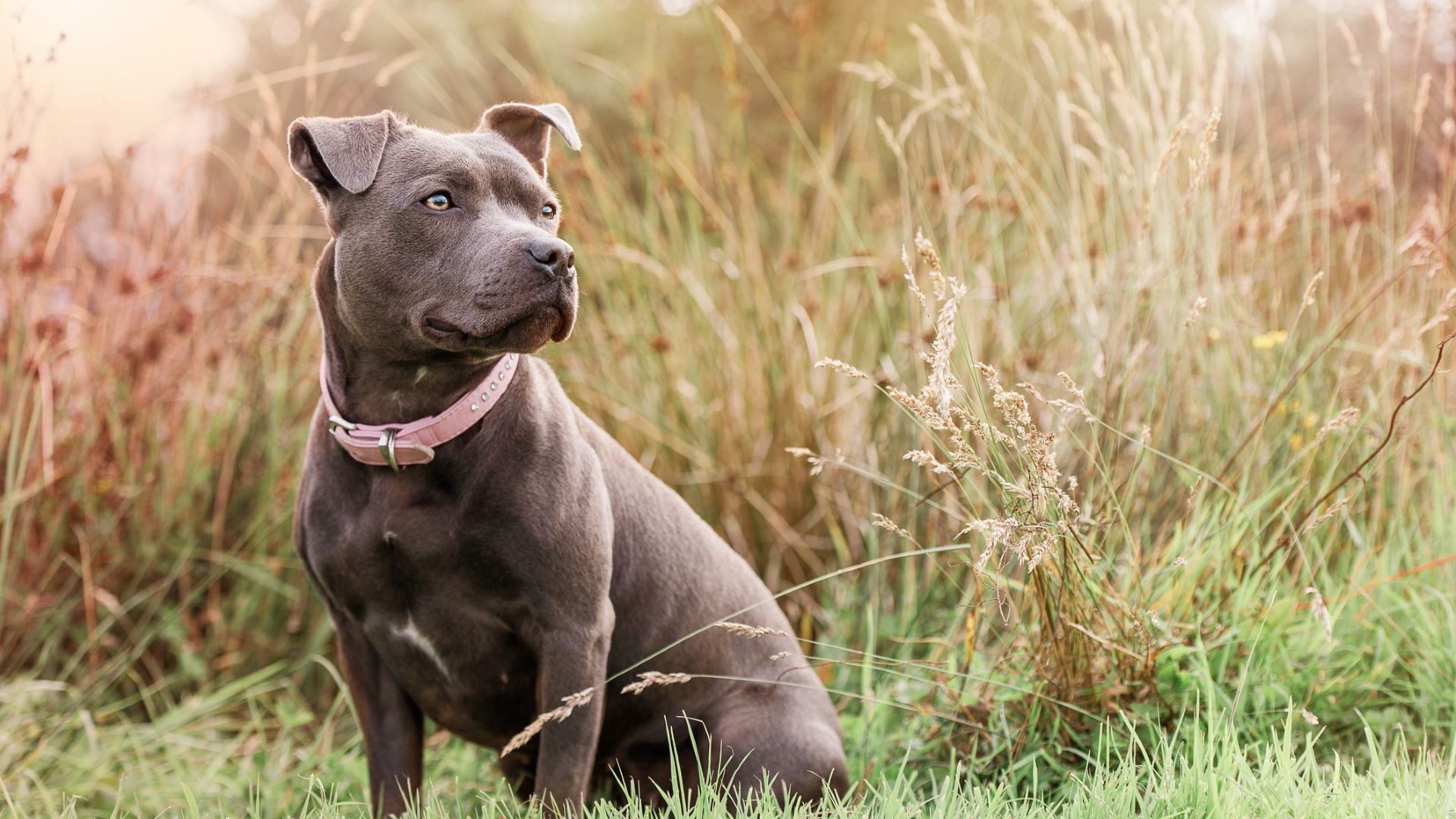

Life expectancy: 12-14 years
Size: 17 to 20 inches (male), 14 to 16 inches (female)
Coat: Short-haired
Temperament: Affectionate, reliable, loyal, fearless, intelligent
Exercise needs: Around an hour daily
Origin/native country: United Kingdom
Originally bred for dog fighting and bull-baiting in England in the mid-1800s, the Staffordshire Bull Terrier has since become a much more loving, affectionate family pet. They are descended from Bull Terriers, which were developed by crossing Bulldogs with various terrier breeds.
It means their muscular, tough, broad-headed appearance is quite at odds with their people-pleasing nature and, as long as they’re well-trained and socialized, they’re sure to go straight to many a pet lover’s heart.
They are, however, excitable and they can be a tad scary for some so you need to be responsible and aware when you’re out and about – it tends to be advisable to keep them on a lead, particularly if other dogs are around. Should you get one though? Here we take a look at this breed in detail with help from expert vet Dr Hannah Godfrey.
Does a Staffordshire Bull Terrier need a lot of exercise?
Staffordshire Bull Terriers have an abundance of energy so you need to help them burn it off by ensuring they exercise for around an hour each day. But you shouldn’t simply take them for a walk – they’re an agile breed so it’s important to build more fun into the dog’s routine.
They love playing tug-of-war and chasing balls and they’ll enjoy joining you on a run or bicycle ride. Give them some scent work to complete and let them engage with the best dog toys as well and you’ll be ensuring a Staffie is sufficiently stimulated both mentally and physically.
Are Staffordshire Bull Terriers easy to train?
According to Stanley Coren’s respected work, The Intelligence of Dogs, Staffordshire Bull Terriers can understand new commands after 25–40 repetitions and they’ll obey the first command around half the time. That makes them reasonably easy to train so long as you get them to focus.
“Staffies are quite easy to train because they’re so eager to please, but it can be a challenge to get their full attention because they’re so excitable,” says Dr Hannah Godfrey. “Therefore, burning off some of their energy on a walk is a good idea before trying to get them to concentrate on learning a new command or trick.”
It can also be a good idea to keep them away from other dogs while you’re training – classes are not ideal – and to socialise this breed early. You should also leash train Staffies because their muscular build means they can pull hard, which will pose problems later on.
Are Staffordshire Bull Terriers aggresssive?
Staffies have a reputation for being aggressive and they have a bite force of around 328 PSI. But research from the UK’s Royal Veterinary College in 2020 actually found no evidence to back up claims that they have an increased risk of aggression compared to other breeds.
“It may, therefore, be time we moved on from these stereotypes, although further research could help determine if this is still the case for specific forms of aggression, such as that directed towards dogs, towards owners or towards strangers," said Camilla Pegram, epidemiologist at the RVC.
Dr Godfrey’s own experience backs up the findings. “Staffordshire Bull Terriers don’t tend to be aggressive,” she says. “Although it’s important to remember that any dog can display ‘aggressive’ behavior if they’re feeling stressed, afraid, or threatened.”

Do Staffordshire Bull Terriers make good family pets?
Many families have a Staffordshire Bull Terrier as a pet and they’ve become known for being exceptionally tolerant of children.
“Despite some people’s perception that they’re ‘tough’ dogs, they are very child-friendly and can make lovely family dogs,” Dr Godfrey says but there are some things to bear in mind.
“I see a lot of Staffies at my practice, and the overwhelming majority are incredibly friendly, happy little dogs,” Dr Godfrey adds. “However, they can be quite clingy and vocal, and they can suffer from separation anxiety.”
It’s a good idea then, to learn how to reduce separation anxiety in dogs but also ensure that someone is around as much as possible.
Do Staffordshire Bull Terriers need a lot of grooming?
This breed has a short, smooth coat which only requires an occasional brush – once a week will more than suffice. You don’t need to bath a Staffie all that often but you do need to pay attention to their skin to be sure they haven’t picked up any fleas.
To that end, it’s worth knowing what fleas look like on pets and to choose the safest flea treatment for dogs. You should also keep a Staffy’s nails in trim and ensure their ears are cleaned of excess wax and debris.
Common health problems in Staffordshire Bull Terriers
Staffordshire Bull Terriers tend to be a rather healthy breed.
“There aren’t many health conditions that I would associate specifically with Staffies,” Dr Godfrey says. “They do sometimes get allergies and skin rashes, and like any dog they can develop osteoarthritis with age, but otherwise, they’re generally a healthy breed.
Should I get a Staffordshire Bull Terrier?
It’s easy to be persuaded against getting a Staffy based on misconceptions but, as we’ve seen, they’re not an inherently aggressive breed and they are, instead, gentle and affectionate and good around children.
To that end, so long as you’re in good shape and can devote time to play and exercise this breed, you should certainly put a Staffy on your list of possible dogs.
Want to learn more about dogs? Here are some of expert behaviorist Helen Master’s favorite dog facts
Edited by Georgia Guerin.







